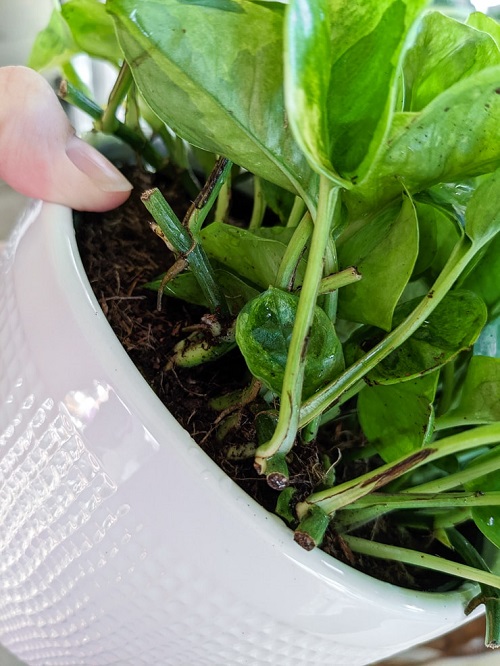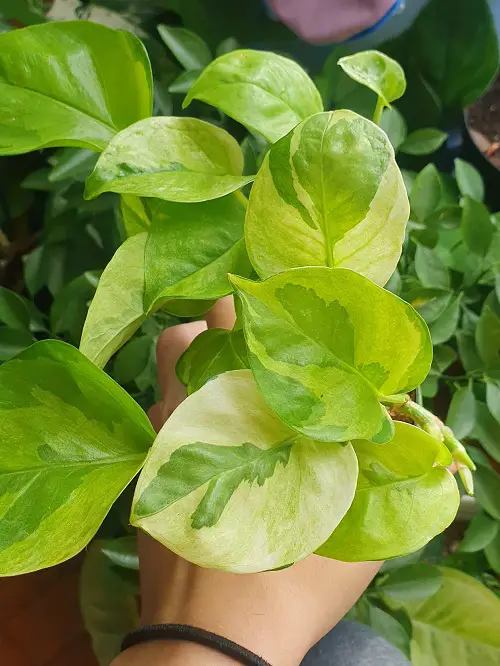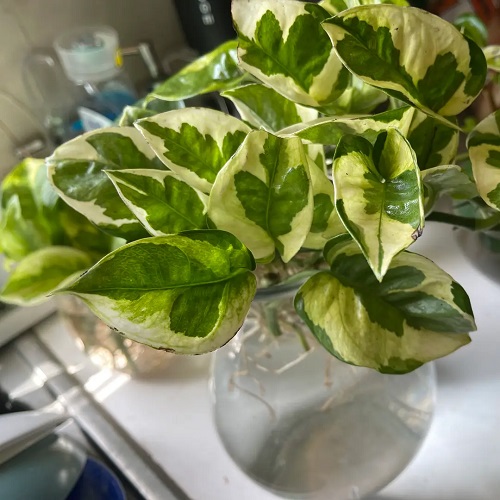Lemon Meringue Pothos stands out with its spectacular variegation of yellow and white on deep green foliage!

Learn How to Grow Manjula Pothos in this Post
Lemon Meringue Pothos Information
Like most pothos, the lemon meringue pothos (Epipremnum aureum ‘Lemon Meringue’) is easy to care for and requires little attention when cultivated indoors.
- Vibrant Variegation: The leaves of Lemon Meringue Pothos exhibit a striking variegation, blending bright yellow and green hues. The yellow portions can range from lemony hues to a more muted, creamy yellow set against a deep green background.
- Typical Height and Spread: Indoors, it can grow to about 4 to 6 feet. However, the height can be controlled through pruning. The spread largely depends on the space it’s allowed to climb or trail. In a hanging basket, the vines can cascade several feet below the pot.
- Growth Rate: It grows at a moderate or a rather slow pace, which can be influenced by light conditions and care.
Read about Baltic Blue Pothos Care and Growing Information in this Post
Propagating Lemon Meringue Pothos

Lemon Meringue Pothos grows best from stem cuttings. Take a 4-6 inches section from a healthy plant with at least two to three nodes. Remove the bottom foliage, and dip the cut end in the rooting hormone (optional). Now, plant it in a pot filled with a well-draining potting mix.
Water well and place the jar in an area with bright, indirect light. The roots will emerge in a couple of weeks.
Find How to Propagate Pothos here
Growing Lemon Meringue Pothos in Water
Begin by selecting a healthy stem from an existing plant, ensuring it has at least 4-6 leaves and a few nodes (the small bumps on the stem where leaves and roots grow).
Cut just below a node using a clean, sharp pair of scissors. Remove the lower leaves to expose the nodes. Fill a transparent jar or vase with room-temperature water and place the stem in it, ensuring the nodes are submerged.
Choose a spot with bright, indirect light for your pothos, avoiding direct sunlight, which can scorch the leaves. Change the water weekly to prevent bacterial growth. Roots should start to develop within a few weeks.
Growing Black Pothos: Scindapsus treubii ‘Dark Form’
Once the roots are a few inches long, you can either continue to grow your Lemon Meringue Pothos in water or transplant it into the soil.
Requirements for Growing Lemon Meringue Pothos

Position
The lemon meringue pothos prefers several hours of medium to bright, indirect sunlight. It can tolerate low light conditions but expect less vibrant colors and slower growth.
Place it near a bright east or west-facing window for robust growth. For south-facing windows, use a curtain to diffuse the light, as the direct sun can scorch the leaves.
Soil
Plant the pothos in rich, airy, and well-draining soil. A potting soil mix with good drainage properties, such as regular indoor potting mix and perlite, coarse sand, orchid bark – works well.
Learn How to Grow Satin Pothos in this Article
Watering
Lemon meringue pothos likes to be watered when the topsoil is dry. Water the plant thoroughly and drain the excess through the drainage holes.
The plant is sensitive to overwatering, so it’s better to wait if in doubt. Overwatering can lead to root rot, so it’s better to slightly underwater than overwater this plant.
PS: Slightly droopy leaves and dry soil can signal that the plant is ready for watering.
Temperature and Humidity
The lemon meringue pothos does well in warm temperatures and average to slightly humid conditions, making it suitable for indoor gardens. It prefers a temperature range of around 60°F to 85°F (15°C to 29°C) during the day. Do not expose it to temperatures below 50°F.
Prevent exposure to cold or freezing temperatures. Avoid placing it in dry conditions – near a drafty window or air vent.
Lemon Meringue Pothos Care

Fertilizer
Fertilize once every 3 to 6 weeks during the growing season, typically spanning from spring through early fall. Reduce or suspend fertilization in colder months when the plant’s growth slows. However, you can feed your plant year-round in a warm climate.
Opt for a balanced, water-soluble fertilizer with a ratio of 10-10-10 or 20-20-20. Dilute it to a quarter to half (1/4 to 1/2) of the recommended strength, following the instructions on the package. Apply when the soil is already damp to prevent root stress.
Pruning
Pruning is not much required for Lemon meringue pothos. However, keep snipping yellowing or damaged leaves when you spot them to improve the plant’s overall appearance and prevent any potential spread of disease.
You can do this throughout the year. However, it’s best to do it in spring or early summer when the plant’s growth is most active.
PS: While pruning, you can use snipped stems to propagate new plants, or showcase them in vases of water!
Read About Growing Epipremnum aureum ‘Jade’ in this Post
Pests and Diseases
The lemon meringue pothos is generally resistant to pests and diseases. However, being vigilant for common houseplant pests such as spider mites, mealybugs, and fungus gnats is essential. Regularly checking your plant during watering can help spot potential infestations early.
Additionally, look out for signs indicating root rot. It is often caused by overwatering. If you find mushy stems, take out the plant from the pot, trim away any rotted roots and stems, and promptly repot it in fresh soil.



